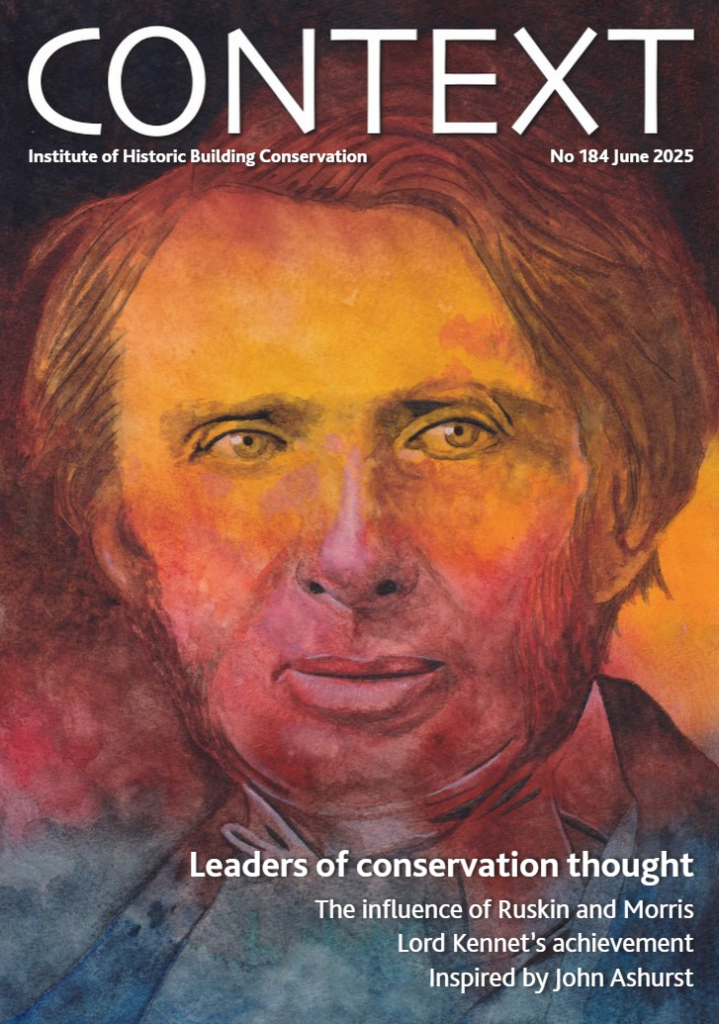
The new issue of IHBC’s members’ journal, Context – No. 184 – selects some ‘Leaders of conservation thought’, familiar and less so, to help Conservation Professionals at any career stage ‘make sense of it all’, and including our regular supplements of current practice, new updates and future plans.
The IHBC writes:
How did historic building conservation get to where it is? Every decision or action that we take is a response, conscious or subconscious, to ever-changing ideas. We can trace them back to John Ruskin, perhaps, but he stood on the shoulders of a host of earlier pioneers and antiquarians. Chronicling the evolution of conservation is not just a case of listing the big names. In every generation, countless thinkers, writers, practitioners and teachers influence each other, apply new methods, and try, succeed or fail….
Some are remembered for their contributions, while many others are soon forgotten and may have never realised their own part in shaping developments in their field. Ideas evolve through a complex interaction between conservationists, architects, planners, archaeologists, landscape architects, architectural historians, surveyors, journalists, teachers, politicians, community leaders and many more. Thinking about conservation from various parts of the world influences theory and practice as thinkers and practitioners interact…
At one time the debate focused on the respective merits of aesthetics and authenticity, repair and restoration. Later, technical issues have been augmented by the idea that the historic environment’s different values need to be taken into account: evidential, historical, aesthetic, communal, cultural, social and environmental; and that different people value different aspects of historic buildings and places. An asset’s protective designation will reflect and describe some particular aspects that are valued. But some people may value other aspects, and appreciate those being taken into account when the future of the asset is considered….
Making the case for conservation depends on relating it to the big themes of the day – themes which themselves evolve as thinkers and practitioners, including politicians, try to make sense of our intractably complex world. The theme may be economic regeneration, sustainability, climate change or resilience. Building conservationists are skilled at explaining how central our skills and knowledge are to each of those issues. The latest big theme is ‘wellbeing’ (see Context 183, March 2025), which seems likely to provide a useful conceptual framework to use in pulling together many strands. In time, like all such concepts, it will no doubt be seen to have limitations, and a new generation will move on to the next big idea in our worthy attempt to make sense of the process of living in and managing the historic environment. This issue of Context focuses on ‘Leaders of conservation thought’. Not all of them, and our authors refer to many people who, while not being big names, have played a significant role in promoting positive advances in the field. What emerges is a complex entanglement of people, ideas, perspectives and practices by which historic building conservation is advancing – and we are all in there somewhere…
See HERE for the full Editorial in Context 184
Context 184: CONTENTS
Themed Articles
- Editorial: Making sense of it all
- Inclusive, values-based conservation to 2008, Kate Clark
- John Ashurst: practitioner, writer and educator, Chris Wood
- SAVE at 50: celebrating half a century of campaigning Eve Blain
- Lord Kennet: making government work, Rebecca Madgin
- Discovering Jane Jacobs, Joe Holyoak
- Nineteenth-century conservation, thinking from Ruskin onwards, Duncan McCallum
Feature Articles
- Replacing Brighton Museum’s roof lantern, Edward Lewis and Olivia Stitson
- The world of generative AI, Sammy Woodford
- Old buildings and oligarchs, Ian Wray
Regular & Occasional features
- Briefing
- Letter
- Periodically, Bob Kindred MBE
- Out of Context
- The writer’s voice
- Law and policy update, Alexandra Fairclough
- Inter alia, James Caird
- Vox pop
- Reviews, Peter de Figueiredo, Reviews Editor,
IHBC Updates
- Notes from the Chair
- Director’s Cut
- New member profile
- New members
Commercial
- Products and services
- Specialist suppliers index
Reading Context helps IHBC members develop their skills across all of the IHBC’s Areas of Competence, and so is a critical baseline in addressing priorities in Continuing Professional Development (CPD)
Access the online archive and see the issue online
See more IHBC background and guidance on IHBC CPD and on how you might use past, current and future issues of Context
See the formal guidance paper on IHBC CPD (scheduled for update)
See more on the IHBC Competences and Areas of Competence
